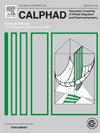Thermodynamic modeling of the Au-Sn-X (X=Bi, Zn, Ni) ternary systems
IF 1.9
3区 材料科学
Q4 CHEMISTRY, PHYSICAL
Calphad-computer Coupling of Phase Diagrams and Thermochemistry
Pub Date : 2025-07-22
DOI:10.1016/j.calphad.2025.102859
引用次数: 0
Abstract
The phase equilibria and thermodynamic properties of Au-Sn-based alloys are of great significance for designing Au-based alloys as lead-free solders to replace high-lead solders. In this work, based on the experimental data reported in the literature, thermodynamic parameters of AuSn2 and AuSn4 in the Au-Sn binary system were modified. The calculated phase diagram and thermodynamic properties of the Au-Sn binary system are in good agreement with the experimental results. Furthermore, by combining the updated calculations of the Au-Sn binary system in this work with the previous assessments of the Au-Bi, Au-Zn, Au-Ni, Sn-Bi, Sn-Zn and Sn-Ni binary systems, thermodynamic modeling of the Au-Sn-X (X = Bi, Zn, Ni) ternary systems was conducted using the CALPHAD method. The liquidus projections, isothermal sections and vertical sections of the Au-Sn-X (X = Bi, Zn, Ni) ternary systems were calculated, which are in good agreement with the reported experimental data. The reasonable thermodynamic parameters of the Au-Sn-X (X = Bi, Zn, Ni) ternary systems were obtained in this work, which would provide a good foundation for further establishing a compatible thermodynamic database of multi-component Au-Sn-based alloy systems to design novel lead-free solders.
Au-Sn-X (X=Bi, Zn, Ni)三元体系的热力学模型
研究金-锡基合金的相平衡和热力学性质对设计替代高铅钎料的无铅钎料具有重要意义。本文在文献实验数据的基础上,修正了Au-Sn二元体系中AuSn2和AuSn4的热力学参数。计算得到的Au-Sn二元体系的相图和热力学性质与实验结果吻合较好。此外,将本文对Au-Sn二元体系的更新计算与之前对Au-Bi、Au-Zn、Au-Ni、Sn-Bi、Sn-Zn和Sn-Ni二元体系的评估相结合,利用calphhad方法对Au-Sn-X (X = Bi, Zn, Ni)三元体系进行了热力学建模。计算了Au-Sn-X (X = Bi, Zn, Ni)三元体系的液相线投影、等温剖面和垂直剖面,结果与实验数据吻合较好。得到了Au-Sn-X (X = Bi, Zn, Ni)三元体系的合理热力学参数,为进一步建立多组分au - sn基合金体系的相容热力学数据库,设计新型无铅焊料奠定了良好的基础。
本文章由计算机程序翻译,如有差异,请以英文原文为准。
求助全文
约1分钟内获得全文
求助全文
来源期刊
CiteScore
4.00
自引率
16.70%
发文量
94
审稿时长
2.5 months
期刊介绍:
The design of industrial processes requires reliable thermodynamic data. CALPHAD (Computer Coupling of Phase Diagrams and Thermochemistry) aims to promote computational thermodynamics through development of models to represent thermodynamic properties for various phases which permit prediction of properties of multicomponent systems from those of binary and ternary subsystems, critical assessment of data and their incorporation into self-consistent databases, development of software to optimize and derive thermodynamic parameters and the development and use of databanks for calculations to improve understanding of various industrial and technological processes. This work is disseminated through the CALPHAD journal and its annual conference.

 求助内容:
求助内容: 应助结果提醒方式:
应助结果提醒方式:


